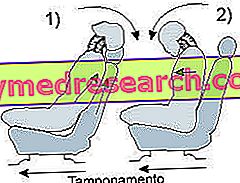Related articles: Transient ischemic attack
Definition
The transient ischemic attack (or TIA or improperly mini-stroke) is a neurological disorder attributable to insufficient blood supply to the brain (focal cerebral ischemia). It is a temporary condition, often due to the presence of a thrombus, an embolus or a stenosis in a blood vessel, which hinders normal cerebral blood supply. The transient ischemic attack differs from ischemic stroke due to the rapid reversibility of symptoms (within 24 hours).
The factors that predispose the onset are numerous. Among the conditions most at risk, there are cardiovascular diseases, abnormal heart rhythms and the presence of atherosclerotic plaques. Other risk factors for transient ischemic attack are diseases that alter the viscosity or coagulability of blood, high blood pressure, high levels of triglycerides and cholesterol, diabetes, smoking, alcohol abuse, the obesity and physical inactivity.
Most common symptoms and signs *
- Tinnitus
- Aphasia
- Agnosia
- Fleeting love
- Apraxia
- dizziness
- Dysarthria
- hemianopia
- hemiparesis
- Hemiplegia
- Tingling in the right arm
- Tingling in the Left Arm
- Tingling in the right hand
- Tingling in the head
- Tingling in the hands
- Tingling in the legs
- Hypoaesthesia
- Headache
- Paresthesia
- Loss of coordination of movements
- Loss of balance
- presyncope
- Reduced vision
- Drowsiness
- Confusional state
- Fainting
- Dizziness
- Double vision
Further indications
The transient ischemic attack arises suddenly, with symptoms reminiscent of an ischemic stroke. Unlike the latter, however, the manifestations last from a few minutes to a few hours, and then resolve spontaneously without leaving permanent brain damage.
The most frequent symptoms are: headache (excruciating), sudden loss of vision (or part of the visual field), decreased sensitivity, motor deficit of the upper limbs or weakness of one half of the body. Furthermore, facial paresis, difficulty walking and maintaining balance, problems in understanding and articulating words may appear. In some cases, alterations in the state of vigilance and loss of consciousness occur. The appearance of other neurological deficits depends on the area of the brain that is lacking in the blood supply.
A transient ischemic attack must always be handled as an emergency, as it often anticipates a real stroke.
The diagnosis involves the performance of clinical and instrumental tests, such as computerized axial tomography (CT), magnetic resonance imaging, cerebral angiography, echocardiography (transthoracic or transesophageal) and blood tests, together with screening for factors of risk of stroke.
The treatment of a transient ischemic attack involves the correction, with an appropriate pharmacological therapy, of the thrombotic or embolic disorders that triggered the disorder. When the case requires it, surgery is also required (eg carotid endarterectomy and arterial angioplasty with stent placement). Lifestyle changes (smoking cessation, regular physical activity and proper nutrition) can prevent further transient ischemic attacks.



